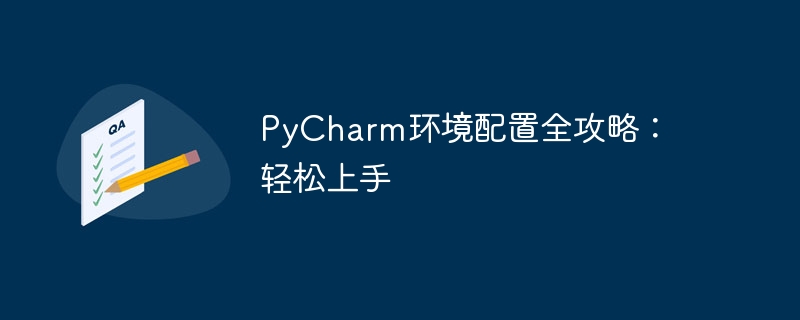Home >Backend Development >Python Tutorial >PyCharm Environment Setup Guide: Quick Start
PyCharm Environment Setup Guide: Quick Start
- WBOYWBOYWBOYWBOYWBOYWBOYWBOYWBOYWBOYWBOYWBOYWBOYWBOriginal
- 2024-02-25 22:00:071268browse

PyCharm environment configuration guide: easy to get started, specific code examples are required
PyCharm is a powerful integrated development environment (IDE) developed by JetBrains, specifically For Python development. It provides a wealth of features and tools to make writing, debugging, and managing Python code more efficient and convenient. In this article, we will introduce how to configure the PyCharm environment to make it easy for you to get started, and provide specific code examples to help you better use this powerful tool.
Step One: Download and Install PyCharm
First, you need to download and install PyCharm. You can open the JetBrains official website and select the appropriate version to download. After the installation is complete, open PyCharm, you will see a welcome interface, click "Create New Project" to start a new project.
Step 2: Configure the Python interpreter
When creating a new project, PyCharm will ask you to configure the Python interpreter. If you have already installed Python, you can select an existing interpreter or click "New Environment" to install a new interpreter. After selecting an interpreter, PyCharm will automatically create a virtual environment for you, which helps isolate project dependencies.
Step 3: Add project files
After creating the project, you can add Python files in PyCharm. Right-click the project folder and select "New" -> "Python File" in the pop-up menu to create a new Python file. You can also import existing Python files.
Step 4: Coding and Debugging
Writing code in PyCharm is very convenient. It provides intelligent code completion and code prompt functions, allowing you to complete code writing faster. You can enter code directly in the editor and press Ctrl+Space to invoke code hints. In addition, PyCharm also supports functions such as automatic code formatting, fast jumps, and code reconstruction, which greatly improves coding efficiency.
After you finish writing the code, you can run the code by clicking the "Run" button on the toolbar. If an error occurs, PyCharm will display detailed error information in the console to help you quickly locate and solve the problem. You can also set breakpoints, step through the code, view the values of variables, and better understand the execution process of the code.
Step 5: Version Control
PyCharm integrates version control tools, such as Git, to facilitate you to manage the version of your code. You can directly operate Git in PyCharm to perform operations such as submission, branch management, and code comparison. This can make team collaboration more efficient and facilitate code version management.
Step 6: Plug-ins and extensions
PyCharm supports a wealth of plug-ins and extensions, which can help you better customize the IDE and improve work efficiency. You can download various plug-ins in PyCharm's plug-in market, such as code inspection tools, code generation tools, theme styles, etc., to meet different programming needs.
Summary
Through the introduction of this article, I believe you already have a preliminary understanding of PyCharm's environment configuration. Configuring an efficient PyCharm environment can help you better perform Python development work. Remember to practice more, practice more, and use specific code examples to familiarize yourself with PyCharm's functions and improve your programming skills. I wish you more progress in using PyCharm!
The above is the detailed content of PyCharm Environment Setup Guide: Quick Start. For more information, please follow other related articles on the PHP Chinese website!

